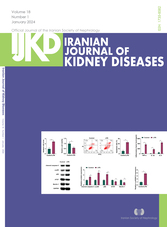The Outcome of Pauci-immune Crescentic Glomerulonephritis and Its Prognostic Factors; A single Center Case Series
Abstract
Introduction. Pauci-immune crescentic glomerulonephritis (GN) is the most common cause of rapidly progressive GN in adults. The aim of this study was to determine the outcome of patients with pauci-immune crescentic GN and risk factors of the development of end-stage kidney disease (ESKD) in these patients. Methods. This case series study was carried on 120 patients with pauci-immune crescentic GN biopsied in our center betwen 1998 and 2016. Inclusion criteria were age > 16 years, at least one crescentic glomerulus, maximally 1+ deposition of immunoglobulins and complement components at fluorescent microscopy, and at least 6 months follow-up. The main outcomes were ESKD and death. Results. The study population included 120 patients with pauciimmune crescentic GN (mean age was 47 ± 17 years and 49.1% male). There was no significant difference in outcome between patients with diffuse or focal crescentic GN. Seventy-two patients (60%) developed ESKD and 31 patients (25.8%) died. The need for dialysis at admission, lower baseline hemoglobin and GFR and GFR at four months and high percentage of glomerulosclerosis and interstitial fibrosis had a significant relationship with low kidney survival (P < .05). The rate of ESKD was higher in patients who did not receive cyclophosphamide therapy, due to focal crescentic GN or high chronicity, compared to patients who received it (70.7 vs. 28.5%, P < .001). Conclusion. In our study, a high percentage of patients with pauciimmune crescentic GN developed ESKD. Low first GFR and high chronicity in biopsy were associated with lower kidney survival. Failure to administer cyclophosphamide in seemingly limited or advanced cases, together with late referral may have led to poor prognosis.
DOI: 10.52547/ijkd.7545
Downloads
Download data is not yet available.
Downloads
Published
2024-02-02
Issue
Section
ORIGINAL | Kidney Diseases
How to Cite
The Outcome of Pauci-immune Crescentic Glomerulonephritis and Its Prognostic Factors; A single Center Case Series. (2024). Iranian Journal of Kidney Diseases, 18(1), 9-17. https://ijkd.org/index.php/ijkd/article/view/7545


